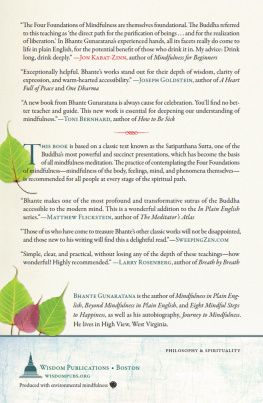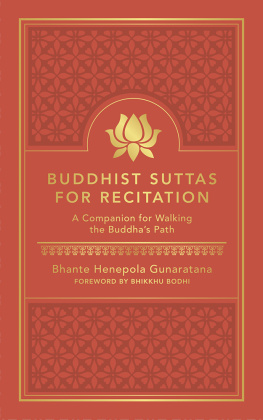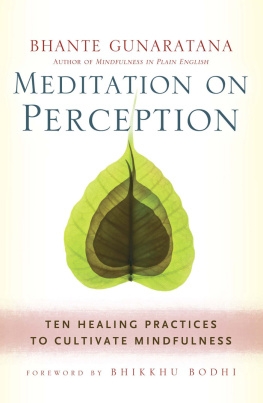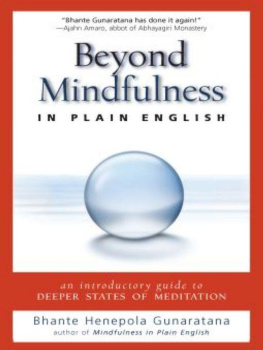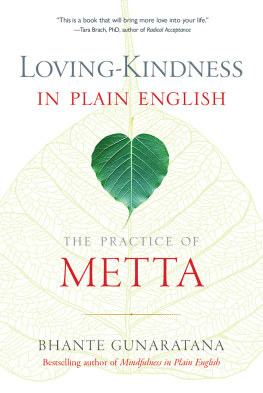
The Four Foundations of Mindfulness in Plain English

Wisdom Publications
199 Elm Street
Somerville, MA 02144 USA
www.wisdompubs.org
2012 Bhante Henepola Gunaratana
All rights reserved.
No part of this book may be reproduced in any form or by any means, electronic or mechanical, including photography, recording, or by any information storage and retrieval system or technologies now known or later developed, without permission in writing from the publisher.
Library of Congress Cataloging-in-Publication Data
Gunaratana, Henepola, 1927
The four foundations of mindfulness in plain English / Bhante Gunaratana.
pages cm
Includes index.
ISBN 1-61429-038-5 (pbk. : alk. paper)
1. Vipasyana (Buddhism) 2. MeditationBuddhism. I. Title.
BQ5630.V5G857 2013
294.34435dc23
2012005119
ISBN 978-1-61429-038-4
eBook ISBN 978-1-61429-042-1
16 15 14 13 12
5 4 3 2 1
Cover and interior design by Gopa&Ted2. Set in Fairfield LT Std Light 11/16.
Wisdom Publications books are printed on acid-free paper and meet the guidelines for permanence and durability of the Production Guidelines for Book Longevity of the Council on Library Resources.
Printed in the United States of America.
This book was produced with environmental mindfulness. We have elected to print this title on 30% PCW recycled paper. As a result, we have saved the following resources: 29 trees, 12 million BTUs of energy, 2,934 lbs. of greenhouse gases, 13,229 gallons 839 water, and 839 lbs. of solid waste. For more information, please visit our website, www.wisdompubs.org. This paper is also FSC certified. For more information, please visit www.fscus.org.
Contents


T HERE ARE several books on the Four Foundations of Mindfulness. Some of them are direct translations of the original Pali discourse of the historical Buddha, some explain the sutta in great detail with commentaries and subcommentaries, some are rich scholarly treatises. And if you are interested in improving your theoretical knowledge of meditation, any of these books can be highly recommended.
When I teach meditation I always try to make sure the listeners can receive the message easily and put it into practice even without a teacher around to consult; as always, my concern in this book is the actual practice, right here in our lives. And when I write, I strive to write everything in plain English.
Meditation is becoming very popular these days for many good reasons. Unfortunately, there are not enough accessible teachers to fully meet the demand of these burgeoning explorers. Some would-be students read good meditation books, some attend meditation retreats, and some listen to many good talks on meditation. After reading books on meditation, listening to talks on meditation, and attending meditation retreats, quite a number of students of meditation write me at the Bhavana Society with questions on matters they would like clarified. I thought of writing this book to answer some, not all, of the questions. Of course, nobody can write one book or series of books answering all the questions people ask! And whats more, as people delve more deeply, their enthusiasm prompts them to ask more questions. The present book is my humble attempt to answer some of the questions related to meditation.
I sincerely thank Ajahn sona, one of our students at the Bhavana Society, for his valuable help in getting this book started. I am grateful to Josh Bartok and Laura Cunningham at Wisdom Publications for making many valuable suggestions to complete this book and for shepherding it to completion, and to Brenda Rosen who contributed enormous time and effort to develop the manuscript.
Bhante Henepola Gunaratana
Bhavana Society
High View, West Virginia

T HE F OUR F OUNDATIONS OF M INDFULNESS is a talk or perhaps a collection of talks said to have been given by the historical Buddha. Mindfulness or insight meditation is based on the Four Foundations. Now very well known in the West, this comprehensive set of meditation topics and techniques is probably the preeminent style of meditation taught today in the Theravada Buddhist world.
Mindfulness has also been the focus of my books. In Mindfulness in Plain English, I present a practical step-by-step guide to mindfulness meditation. If you are new to insight practice, this book is a good place to start. In Eight Mindful Steps to Happiness, I show how mindfulness is used to progress along the Buddhas eight-step path to happiness. You could say that the Four Foundations are the details of the seventh step of the Buddhas path. In fact, the last three stepseffort, mindfulness, and concentration, which we in the West call meditationare all covered in the Four Foundations. In Beyond Mindfulness in Plain English, I explain the principles and techniques of deep concentration meditation. Concentration meditation or samatha is parallel and complementary to mindfulness meditation or vipassana, since the Four Foundations are the basis of all concentration.
Now, in this book, I write directly about the Four Foundations, the underlying principles of mindfulness practice. In simple and straightforward language, I share what the Buddha said about mindfulness in his instructional talks or suttas and how we can use these principles to improve our daily lives, deepen our mindfulness, and move closer to our spiritual goals.
The basic premise of mindfulness is simple. The body does many things without our awareness. When germs invade, our white blood cells attack the invaders without our knowledge. However, we can train ourselves to become aware of the things we do consciously with the body, such as walking, standing, talking, eating, drinking, writing, reading, playing, and other physical activities. We can also develop moment-to-moment awareness of our emotions, sensations, thoughts, and other mental activities. Mindfulness trains us to do everything we do with full awareness.
You may be wondering, Why is full awareness important? As anyone who tries mindfulness practice quickly discovers, the more aware we are of our actions and of the feelings, thoughts, and perceptions that give rise to them, the more insight we have into why we are doing what we are doing. Awareness allows us to see whether our actions spring from beneficial or harmful impulses. Beneficial motivations include generosity, friendliness, compassion, and wisdom; harmful actions are caused primarily by greed, hatred, and delusion. When we are mindful of the deep roots from which our thoughts, words, and deeds grow, we have the opportunity to cultivate those that are beneficial and weed out those that are harmful.
The Buddha is very clear that the primary aim of all his teachings is the end of suffering. Mindfulness helps us to recognize that beneficial actions bring peace of mind and happiness to our everyday lives. They also help us progress on the Buddhas path toward
Next page
